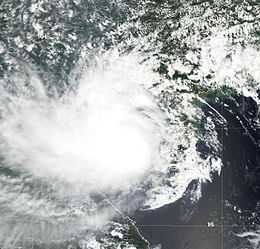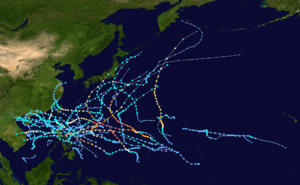Tropical Storm Mujigae (2009)
| Tropical storm (JMA scale) | |
|---|---|
| Tropical depression (JTWC scale) | |
 Tropical storm Mujigae on September 11 | |
| Formed | September 8, 2009 |
| Dissipated | September 12, 2009 |
| Highest winds |
10-minute sustained: 75 km/h (45 mph) 1-minute sustained: 55 km/h (35 mph) |
| Lowest pressure | 990 mbar (hPa); 29.23 inHg |
| Fatalities | 11 direct |
| Damage | $14.6 million (2009 USD) |
| Areas affected | Philippines, Hong Kong, China, Vietnam |
| Part of the 2009 Pacific typhoon season | |
Tropical Storm Mujigae, known in the Philippines as Tropical Depression Maring, formed as a tropical disturbance during September 8, to the northwest of Manila in the Philippines it rapidly consolidated and was designated as Tropical Depression Maring later that day.
Meteorological history

Early on September 8, the Joint Typhoon Warning Center reported that an area of convection had persisted about 340 km (210 mi), to the northwest of Manila in the Philippines.[1] The disturbance had a broad low level circulation center with convection starting to consolidate and was developing along the monsoon trough in favourable conditions.[1] Later that day both the Philippine Atmospheric, Geophysical and Astronomical Services Administration (PAGASA) and the Japan Meteorological Agency (JMA) reported that the disturbance had become a tropical depression with PAGASA assigning the name of Maring to the depression as the low level circulation center became more developed.[2][3] During the next morning the JTWC designated the tropical depression as 14W after the system had rapidly consolidated with deep convective bands forming in the low level circulation center.[4][5] The depression was initially being steered by a low to mid-level ridge to the northeast, however a deeper secondary ridge was expected to assume steering the system to the northeast as it moved out of PAGASA's area of responsibility.[4][6]
During that day the depression rapidly developed further being upgraded to a Tropical storm by the JMA early on September 10 who assigned the international number of 0913 and the name Mujigae to the storm.[7] However at this time Mujigae's low level circulation center was partially exposed with convection confined to the western portion of the low level circulation center due to a moderate amount of vertical wind shear associated with an anticyclone to the northeast of Mujigae affecting the system which prevented Mujigae from intensifying further.[8][9] Mujigae then made landfall early the next day and passed over Northern Hainan Island with observations from Meilan, Hainan, showing that Mujigae was a 55 km/h (35 mph) Tropical Depression.[10] However the JMA did not downgrade Mujigae to a tropical Depression at this time.[11] As Mujigae moved into the Gulf of Tonkin the low level circulation center became less organized with the JTWC forecasting that Mujigae would dissipate within six hours of making landfall on Vietnam.[10] Mujigae then made landfall on Vietnam early on September 12.[12] The JTWC then issued their last advisory with the JMA downgrading Mujigae to a Tropical Depression and then they issued their final advisory as Mujigae remants had dissipated.[12][13][14]
Preparations
Philippines
When PAGASA issued their first warning during September 8, they placed the provinces of Ilocos Sur, La Union, Zambales, Bataan, Western Pangasinan, and Lubang Island were all placed under public storm warning signal one.[2] They kept these warnings in force until early the next day when they canceled the signals for Bataan and Lubang Island, and placed the whole of Pangasinan, Ilocos Norte, Abra under public storm warning signal number 1 before canceling all of the signals later that morning.[15][16] PAGASA also warned throughout their warnings for residents living in low-lying areas and near mountain slopes to take all the necessary precautions against possible flash floods and landslides.[2][6]
Hong Kong
Late on September 9, the Hong Kong Observatory issued the public storm standby signal 1 as Mujigae was located within 800 km (500 mi) of Hong Kong.[17] Early the next day the standby signal was replaced with the storm signal number 3 which meant that strong winds were expected to affect the city.[17] Signal 3 stayed in force for 13 hours until it was replaced with the Storm Signal 1, before the warnings were cancelled two hours later.[17]
Impact
Philippines
On western Luzon including Manila, a 48 hour rainfall were recorded when the depression is just forming. The depression enhanced the southwest monsoon that brought torrential rains in the area. In Laguna, two children were killed due to landslides caused by torrential rains brought by Maring. Late on September 8, both the JMA and the PAGASA declared the system was a minor tropical depression. Also, on September 9, all classes in Manila was suspended from Pre - school, Elementary school, and High school due to incessant raining and flooding. The National Disaster Coordinating Council reported that at least three villages in Malabon City were submerged in 18 inches deep floodwaters. At least four streets in the area were impassable to light vehicles. Also on that day, six provinces was raised in public storm signal no. 1.[18]
In Valenzuela City, 15 low-lying barangays located in the city’s first district are underwater. In Bulacan, five towns and two cities of the province are flooded, with water as high as four feet. In Bataan, the town of Dinalupihan was placed under state of calamity after 22 barangays were affected by flash floods. In Pampanga, the NDCC placed the towns of Sta.Ana, San Luis, Minalin, Mexico, Macabebe, Masantol, Apalit, Guagua, Sasmuan, Lubao, and Bacolor in state of calamity due of rivers in Tarlac are swelling.
More than 300, 000 residents of four northern provinces were affected by floods, including about 3,300 people who fled to evacuation centers and more than 41,000 who moved in with their relatives and friends. Overall damages were estimated of 25 million Philippine Peso in agricultural land.[19]
Hainan Island
As Mujigae made its landfall over the island, the storm has caused economic losses of 56.43 million yuan (8.3million U.S. dollars), with more than 50,00 people evacuated and some farm land, fish ponds, roads and water conservation systems submerged. Flights at the Meilan Airport in province's capital of Haikou were suspended in Thursday afternoon because of strong winds and heavy rain. All inbound and outbound train services in Hainan were suspended. the Qiongzhou strait line between the island and the mainland remains closed from late of September 10 - September 11.[20]
See also
- 2009 Pacific typhoon season
- Typhoons in the Philippines
- Effects of the 2009 Pacific typhoon season in the Philippines
References
- ↑ 1.0 1.1 "Significant Tropical Weather Advisory for the Western and Southern Pacific ocean 2009-09-08 06z". Joint Typhoon Warning Center. 2009-09-08. Retrieved 2009-09-10.
- ↑ 2.0 2.1 2.2 "Tropical depression 'Maring' threatens W. Luzon". abs-cbnNEWS.com. 2009-09-08. Retrieved 2009-09-12.
- ↑ "JMA WWJP25 Advisory 2009-09-08 18z". Japan Meteorological Agency. 2009-09-08. Retrieved 2009-09-10.
- ↑ 4.0 4.1 "JTWC Tropical Cyclone Advisory 2009-09-09 09z". Joint Typhoon Warning Center. 2009-09-09. Retrieved 2009-09-10.
- ↑ "Prognastic reasoning for Tropical Depression 14W 2009-09-09 15z". Joint Typhoon Warning Center. 2009-09-09. Retrieved 2009-09-10.
- ↑ 6.0 6.1 "PAGASA Tropical Cyclone Advisory 2009-09-09 15z". Philippine Atmospheric, Geophysical and Astronomical Services Administration. 2009-09-09. Retrieved 2009-09-10.
- ↑ "JMA Tropical Cyclone Advisories: 2009-09-10 00z". Japan Meteorological Agency. 2009-09-10. Retrieved 2009-09-12.
- ↑ "Prognastic reasoning for Tropical Depression 14W 2009-09-10 03z". Joint Typhoon Warning Center. 2009-09-10. Retrieved 2009-09-10.
- ↑ "Prognastic reasoning for Tropical Depression 14W 2009-09-10 15z". Joint Typhoon Warning Center. 2009-09-10. Retrieved 2009-09-10.
- ↑ 10.0 10.1 "Prognastic reasoning for Tropical Depression 14W 2009-09-11 03z". Joint Typhoon Warning Center. 2009-09-11. Retrieved 2009-09-11.
- ↑ "JMA Tropical Cyclone Advisory 2009-09-11 00z". Japan Meteorological Agency. 2009-09-11. Retrieved 2009-09-12.
- ↑ 12.0 12.1 "JTWC Tropical Cyclone Advisory 2009-09-12 00z". Joint Typhoon Warning Center. 2009-09-12. Retrieved 2009-09-12.
- ↑ "JMA Tropical Cyclone Advisories: 2009-09-12 00z". Japan Meteorological Agency. 2009-09-12. Retrieved 2009-09-12.
- ↑ "JMA WWJP25 Advisory 2009-09-12 00z". Japan Meteorological Agency. 2009-09-12. Retrieved 2009-09-12.
- ↑ "PAGASA TC Advisory 2009-09-09 03z". Philippine Atmospheric, Geophysical and Astronomical Services Administration. 2009-09-09. Retrieved 2009-09-12.
- ↑ "PAGASA TC Advisory 2009-09-09 09z". Philippine Atmospheric, Geophysical and Astronomical Services Administration. 2009-09-09. Retrieved 2009-09-12.
- ↑ 17.0 17.1 17.2 "HKO Warnings and Signals Database: Tropical Cyclone Warning Signals:Mujiage". Hong Kong Observatory. 2009-09-12. Retrieved 2009-09-12.
- ↑ http://ph.news.yahoo.com/star/20090909/tph-signal-no-hoisted-over-areas due-mar-541dfb4.html
- ↑ http://ph.news.yahoo.com/abs/20090909/tph-deped-suspends-elementary-highschool-898cf49.html
- ↑ Xiong Tong (September 10, 2009). "Tropical storm Mujigae lands in S China island province". Xinhua. Retrieved September 12, 2009.
External links
| Wikimedia Commons has media related to Tropical Storm Mujigae (2009). |
- JMA General Information of Tropical Storm Mujigae (0913) from Digital Typhoon
- JMA Best Track Data of Tropical Storm Mujigae (0913) (Japanese)
- JTWC Best Track Data of Tropical Depression 14W (Mujigae)
- 14W.MUJIGAE from the U.S. Naval Research Laboratory
| ||||||||||||||||||||||||||||||||||||||||||||||||||||||||||||||||||||||||||||||||||||||||||||||||||||||||||||||||||||||||||||||||||||||||
